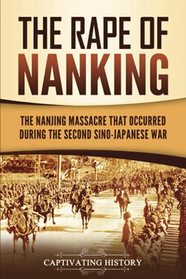The author describes THE RAPE OF NANKING as one of the most horrific atrocities of World War II. We don't hear as much about atrocities that took place in the East. This particular massacre lasted six weeks. Most of the records were destroyed so that historians do not know how many people were killed. The estimates are between 40,000 and 300,000 unarmed people were murdered during this time. It was seven years after the massacre that information came to light; by that time much had been destroyed.
As is Captivating History's habit, they set the scene. Japan was very aggressive, especially in the years between the world wars. They were challenging their weaker (although much larger) neighbor, China. The explanation of the "Three Alls" Policy was chilling. Another shocking explanation was the "Warrior Code" and the indoctrination of 14-year-olds (who were inducted into the Japanese military). It was all based on the ancient samurai noble code of conduct. It was of the highest nobility to die for one's emperor. Seppuku (committing suicide to atone for failure or loss) and kamikaze (pilots who killed themselves by taking as many of their enemy with them) were taught.
The Japanese had a difficult time subduing Shanghai and they were angry. By the time they got to Nanjing, they needed to show that they were superior to the Chinese. The people left in the city, with barely-trained recruits, was a recipe for disaster. However, there were rules. The Hague Convention of 1899 and 1907 forbade war crimes against citizens and prisoners of war. The Geneva Convention of 1929 also dictated the humane treatment of prisoners. The execution of prisoners and civilians would be explicitly forbidden under those rules.
The Japanese operated under the rule of "better ten innocents dead than an ex-soldier free." The people and soldiers had surrendered and should have been treated humanely. The descriptions are truly appalling. The author makes a point that the murders, rapes, mutilations, etc., were not because of undisciplined soldiers, but a complete disregard for international law by the officers. As much as 1/3 of Nanking was destroyed by the looting and burning of buildings, businesses, and culture.
Foreigners in the Safety Zone of Nanking started writing letters to Japanese diplomats, hoping to stop the carnage. Instead, the military continued to call the soldiers heroes to the Japanese population. The first investigation began with Lewis Smythe, an American Christian missionary, in March 1938. General MacArthur's concern about Japan remaining a democracy is the reason given for the few crimes trials and executions. I wonder how that played with the Chinese after the war.
I really appreciated the new addition of subheadings; they help break up extra long sections with meaningful text explanations.
As is Captivating History's habit, they set the scene. Japan was very aggressive, especially in the years between the world wars. They were challenging their weaker (although much larger) neighbor, China. The explanation of the "Three Alls" Policy was chilling. Another shocking explanation was the "Warrior Code" and the indoctrination of 14-year-olds (who were inducted into the Japanese military). It was all based on the ancient samurai noble code of conduct. It was of the highest nobility to die for one's emperor. Seppuku (committing suicide to atone for failure or loss) and kamikaze (pilots who killed themselves by taking as many of their enemy with them) were taught.
The Japanese had a difficult time subduing Shanghai and they were angry. By the time they got to Nanjing, they needed to show that they were superior to the Chinese. The people left in the city, with barely-trained recruits, was a recipe for disaster. However, there were rules. The Hague Convention of 1899 and 1907 forbade war crimes against citizens and prisoners of war. The Geneva Convention of 1929 also dictated the humane treatment of prisoners. The execution of prisoners and civilians would be explicitly forbidden under those rules.
The Japanese operated under the rule of "better ten innocents dead than an ex-soldier free." The people and soldiers had surrendered and should have been treated humanely. The descriptions are truly appalling. The author makes a point that the murders, rapes, mutilations, etc., were not because of undisciplined soldiers, but a complete disregard for international law by the officers. As much as 1/3 of Nanking was destroyed by the looting and burning of buildings, businesses, and culture.
Foreigners in the Safety Zone of Nanking started writing letters to Japanese diplomats, hoping to stop the carnage. Instead, the military continued to call the soldiers heroes to the Japanese population. The first investigation began with Lewis Smythe, an American Christian missionary, in March 1938. General MacArthur's concern about Japan remaining a democracy is the reason given for the few crimes trials and executions. I wonder how that played with the Chinese after the war.
I really appreciated the new addition of subheadings; they help break up extra long sections with meaningful text explanations.




